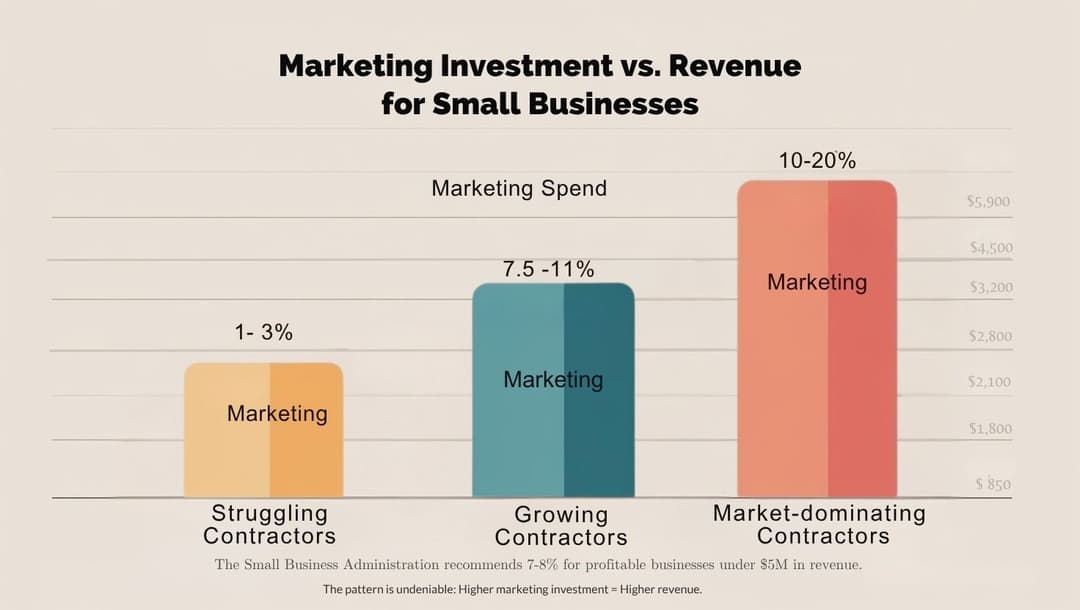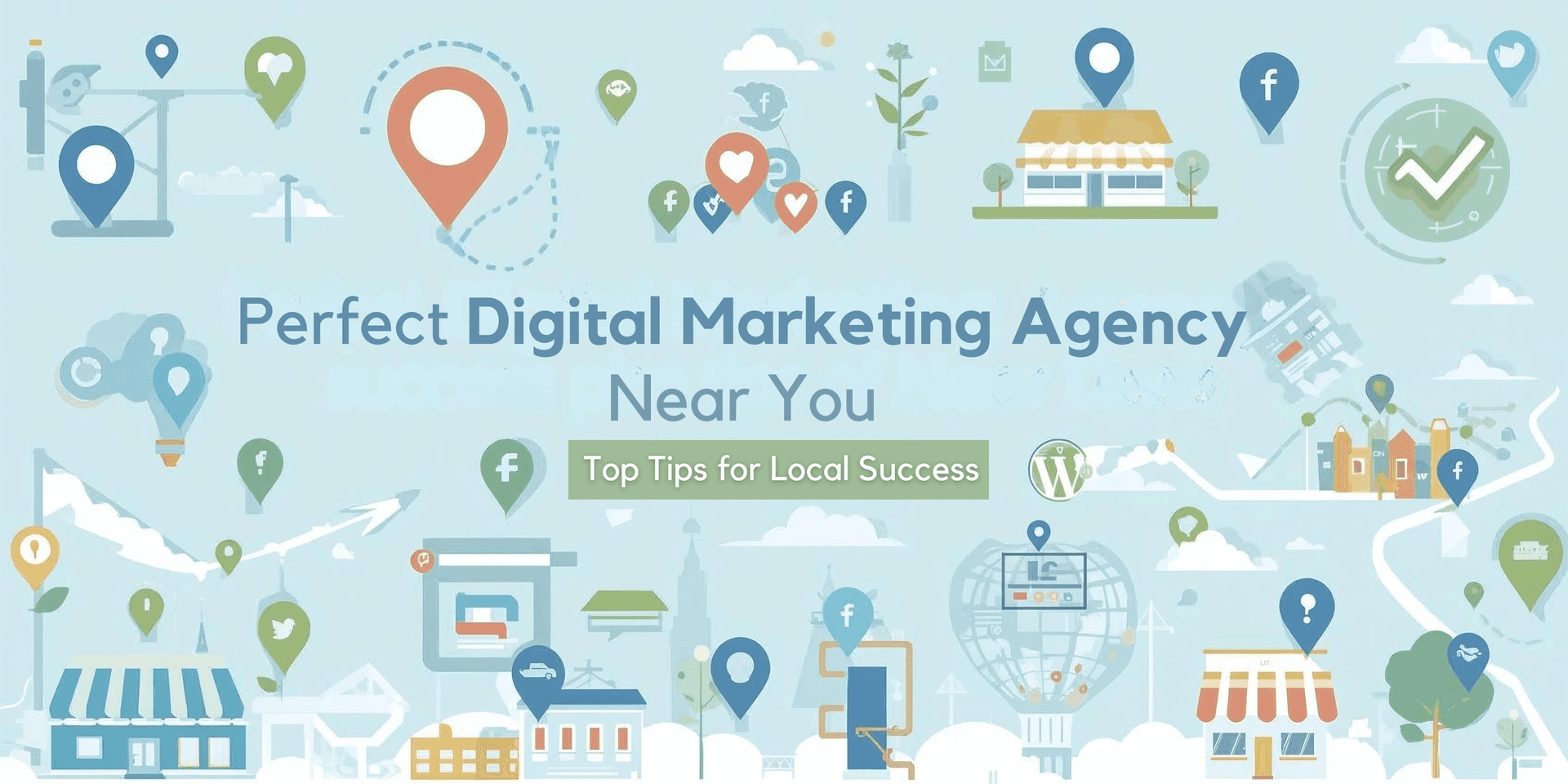Support center (714) 707-2483
The Contractor Growth Formula: Why 3% Keeps You Broke While 10% Makes You Rich

How a simple marketing budget shift separates struggling contractors from industry leaders
Here's a hard truth that'll sting: The difference between contractors who thrive and those who barely survive isn't technical skill, equipment quality, or even pricing. It's a simple number that most contractors get catastrophically wrong.
That number? Your marketing investment percentage.
And the data is brutal.
The Tale of Two Contractors
Meet Mike and Jake. Both run HVAC companies in similar markets. Both started around the same time. Both are excellent technicians with solid reputations.
Mike invests 3% of his gross revenue in marketing. "Marketing is an expense," he says. "I keep it lean so I can maximize profit margins."
Jake invests 10% of his gross revenue in marketing. "Marketing is my growth engine," he believes. "Every dollar I put in brings back more."
Five years later:
- Mike's business: $800K annual revenue, same 3 trucks, constant cash flow stress, competing on price
- Jake's business: $2.4M annual revenue, 12 trucks, booked solid, premium pricing, turning work away
Same market. Same skills. Different mindset about marketing investment.
The result? Jake's business is 3x larger than Mike's.
This isn't luck. It's math.
The Shocking Reality of Marketing Spend in Construction
According to the 2021 CMO Survey, B2B service companies (like contractors) spend an average of 15.5% of their revenue on marketing. However, the study shows Mining and Construction companies spending just around 3% of their revenue on marketing.
Let that sink in.
While other B2B service industries invest 15.5% and dominate their markets, most contractors are stuck at 3% and wondering why their phones don't ring.
The Small Business Administration recommends 7-8% for profitable businesses under $5M in revenue. The U.S. Small Business Administration says typical marketing spending for profitable businesses making less than $5 million in sales annually is about 8% of the total revenue.
But here's what the data really shows:
- Struggling contractors: 1-3% of revenue on marketing
- Growing contractors: 7.5-11% of revenue on marketing
- Market-dominating contractors: 10-20% of revenue on marketing
The pattern is undeniable: Higher marketing investment = Higher revenue.
Why 3% Keeps You in Survival Mode
When you invest just 3% of revenue in marketing, you're essentially telling the market: "I don't want to grow."
Here's what 3% gets you:
Limited Digital Presence
- Basic website that doesn't convert
- Minimal SEO (you're buried on page 5 of Google)
- Inconsistent social media
- No systematic lead generation
Feast or Famine Cycles
- Crazy busy during peak seasons
- Dead slow during off-seasons
- No predictable lead flow
- Constant anxiety about next month's revenue
Price Competition
- Customers only find you through word-of-mouth
- No differentiation from competitors
- Forced to compete on price alone
- Lower profit margins
Reactive Marketing
- Only market when business is slow
- No long-term strategy
- Emergency spending on tactics that don't work
- Wasted money on random ads
Bottom line: 3% marketing spend keeps you invisible, unremarkable, and replaceable.
Why 10% Creates Market Dominance
When you invest 10% of revenue in marketing, everything changes. You shift from hoping for customers to systematically attracting them.
Here's what 10% gets you:
Market Visibility
According to ServiceTitan, HVAC contractors need to dedicate 10% to 20% of sales toward their HVAC marketing budget if they truly want to grow their business. A 5% marketing budget is considered a small "maintenance" budget that yields minimal results.
- Professional website that converts visitors to leads
- Top 3 Google rankings for "HVAC repair near me"
- Strategic paid advertising that targets your ideal customers
- Content marketing that positions you as the local expert
Predictable Lead Flow
- Consistent monthly leads regardless of season
- Multiple lead sources (organic, paid, referrals, social)
- Lead nurturing systems that convert prospects over time
- Seasonal campaigns that maximize peak opportunities
Premium Positioning
- Brand recognition in your market
- Customer education that justifies higher prices
- Social proof through reviews and case studies
- Authority positioning as the go-to expert
Strategic Growth
- Data-driven decisions based on ROI tracking
- Systematic testing of new marketing channels
- Long-term asset building (SEO, content, reviews)
- Compound growth where each marketing dollar works harder
The result: 10% marketing spend makes you the obvious choice, not the cheapest option.
The Math That Changes Everything
Let's run the numbers on a $1M contractor:
3% Marketing Investment ($30K/year):
- Website: $3,000
- Basic SEO: $6,000
- Google Ads: $15,000
- Misc: $6,000
- Result: Minimal visibility, inconsistent leads, 5% annual growth
10% Marketing Investment ($100K/year):
- Professional website & optimization: $15,000
- Comprehensive SEO: $24,000
- Strategic Google Ads: $36,000
- Content marketing: $12,000
- Social media & reputation management: $8,000
- Misc & testing: $5,000
- Result: Market dominance, consistent leads, 25-40% annual growth
The 10% investor generates 5-8x better results for just 3.3x the investment.
Research shows that PPC returns $2 for every $1 spent—resulting in a 200% ROI, while 49% of businesses say that organic search brings them the best marketing ROI.
Real-World Success Stories
Jupiter-Tequesta Air Conditioning
The small mom-and-pop HVAC company used ServiceTitan's Marketing Pro for their email marketing campaign. The company's one-time "We Miss You!" email marketing message triggered a flood of HVAC leads and has garnered $60K+ in revenue for their company.
One email. $60,000+ in revenue.
That's the power of systematic marketing investment.
ServiceOne Air Conditioning
ServiceOne saw 20% growth year over year, with 10% organic lead growth and a whopping 100% increase in organic traffic after shifting toward digital marketing.
The owner's quote: "Digital marketing helped save our company."
The Pattern Across Industries
Blue Corona's SEO case studies show contractors achieving 748% average organic ROI compared to just 440% from paid ads alone. Content marketing generates 54% more leads than traditional marketing, while 49% of businesses report organic search delivers their best marketing ROI.
748% ROI means every $1,000 invested in SEO returns $7,480.
These aren't unicorns. They're contractors who understand the growth formula.
The Hidden Cost of Under-Investment
Here's what most contractors miss: Under-investing in marketing doesn't save money—it costs money.
When you invest only 3%, you're actually losing money through:
Opportunity Cost
- Lost jobs that go to more visible competitors
- Lower pricing power due to lack of differentiation
- Slower growth that compounds over years
- Market share erosion as competitors out-invest you
Inefficiency Cost
- Higher cost per lead due to limited scale
- Wasted ad spend on unoptimized campaigns
- Emergency marketing during slow periods
- Random tactics instead of systematic strategy
The Recession Advantage
Marketing experts suggest investing more company revenue into marketing during economic downturns is the smarter move. Maintaining your marketing activities shows that your brand can hold it down even during periods of economic hardship.
While competitors cut marketing during tough times, smart contractors increase investment and capture market share.
The 10% Investment Breakdown
Here's how to strategically deploy 10% of revenue for maximum impact:
Digital Foundation (40% of budget)
- Website optimization: 15%
- Search engine optimization: 25%
Lead Generation (45% of budget)
- Google Ads: 25%
- Local Services Ads: 10%
- Social media advertising: 10%
Brand Building (15% of budget)
- Content marketing: 8%
- Review management: 4%
- Community involvement: 3%
This allocation ensures both immediate leads and long-term market position.
The Compound Effect
Here's where 10% investment gets really powerful: compound growth.
Year 1: Foundation Building
- Website ranks higher
- Ad campaigns optimize
- Review count increases
- Brand awareness grows
Year 2: Momentum Building
- SEO starts paying dividends
- Ad costs decrease due to higher Quality Scores
- Referrals increase from satisfied customers
- Market position strengthens
Year 3+: Market Dominance
- Top rankings for key search terms
- Premium pricing due to strong brand
- Consistent lead flow from multiple sources
- Competitors struggle to catch up
The contractor who invests 10% for three years becomes nearly impossible to displace.
Making the Shift: From 3% to 10%
"But Ryan," you might say, "I can't afford to spend 10%!"
The real question is: Can you afford NOT to?
Here's how to make the transition:
Phase 1: Foundation (Months 1-3)
- Audit current marketing ROI
- Invest in website optimization
- Set up proper tracking systems
- Begin systematic SEO efforts
Phase 2: Expansion (Months 4-6)
- Launch strategic Google Ads
- Implement review generation system
- Start content marketing program
- Optimize based on data
Phase 3: Acceleration (Months 7-12)
- Scale successful campaigns
- Add new marketing channels
- Increase market penetration
- Build competitive moats
Start where you are, but start moving toward 10%.
The Bottom Line
Data suggests that digital marketing campaigns can yield an average ROI of 200-400% for HVAC businesses, whereas traditional methods might offer different returns.
The formula is simple:
- 3% investment = Survival mode
- 10% investment = Growth mode
- The difference = Everything
The contractors thriving right now—the ones with full schedules, premium pricing, and multiple revenue streams—aren't necessarily better technicians. They're better marketers.
They understand that in today's market, marketing isn't an expense—it's the most profitable investment you can make.
Every month you delay this shift is another month your competitors gain ground. Every dollar you don't invest in marketing is revenue you'll never see.
The question isn't whether you can afford to invest 10% in marketing.
The question is whether you can afford not to.
Ready to Make the Shift?
The data is clear. The formula works. The only question left is: Will you join the 10% club?
If you're ready to stop surviving and start thriving, let's talk about building your growth engine.
About the Author: Ryan Goering has been helping contractors grow their businesses through strategic digital marketing since 2008. His clients have achieved revenue growth from $600K to $1.8M, 196% increases in booked calls, and 28% higher conversion rates. He believes every contractor deserves a full schedule and premium pricing—it just takes the right marketing investment formula.
Sources: All statistics cited from industry research including ServiceTitan, CMO Survey, U.S. Small Business Administration, Blue Corona case studies, and HubSpot marketing data.




